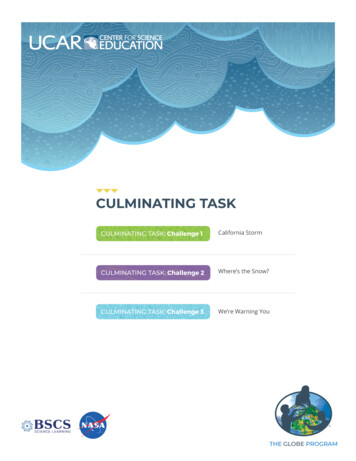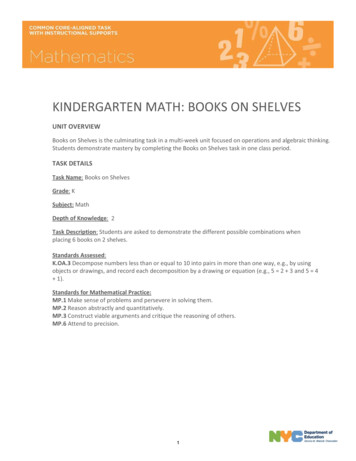
Transcription
CULMINATING TASKCalifornia StormWhere’s the Snow?We’re Warning YouTHE GLOBE PROGRAM
NamePeriodDateWhy did the storm cause rain in some places andsnow in other places in California?On February 20, 2017, a storm passed through California on the West Coast of the United States. The storm broughtextreme rainfall which caused flooding and mudslides in some places. The storm brought deep snow to mountainousareas of California.U S A TO DAY:Battered Northern California blasted by new storm“The National Weather Service was calling for up to eight inches of rain over parts of the regionMonday and Tuesday. Wind gusts in some areas could reach 65 mph. Flood warnings for a handful ofrivers could last until week’s end — this for a state that two months ago was mired in severe drought.Heavy snow was forecast to pound the Sierra Nevada Mountains, where totals will be measured infeet, not inches.”February 21, 2017LKey:OregonLIdahocenter of alow pressureareacoldfrontWyomingWyomingNevada60 NUtahColorado30 OCEANNew Mexico0 (equator)30 S60 S62 2019 University Corporation for Atmospheric Research. All Rights Reserved.GLOBE Weather Culminating Task: Challenge 1
Why did the storm cause rain in some places and snowin other places in California?STEP 1: Analyzing the California storm.Use the maps on the previous page and what you have learned about storms to answer the questions below.631.Based on what you learned about global winds, where do you think the cold front was located before it passedover California?2.For a storm to cause rain and snow, there must be moisture in the air (humidity). Where do you think themoisture in this storm came from before it was in the atmosphere? Consider what you know about the watercycle as you answer.3.Based on what you learned about cold fronts and the symbols on the weather map on the previous page, wheredo you think the storm will go next? How do you know? 2019 University Corporation for Atmospheric Research. All Rights Reserved.GLOBE Weather Culminating Task: Challenge 1
Why did the storm cause rain in some places and snowin other places in California?STEP 2: More details about the California storm: On February 21, 2017, the town of South LakeTahoe, California, had 6.1 cm (2.4 inches) of rain. Meanwhile, the nearby summit of HeavenlyMountain had 61 cm (24 inches) of snow.1.What information would you need to decide whether rain or snow will fall during a storm? Explain your answer.2.Look below at the cross section showing the town of South Lake Tahoe and Heavenly Mountain. Use what youknow about the atmosphere to explain why it snowed on Heavenly Mountain, but rained in the town of SouthLake Tahoe.3.Draw on the cross section below.a. Indicate where the atmosphere is colder and where the atmosphere is warmer.b. Indicate the location where it rained and the location where it snowed. Also indicatewhere along the ground you think a rain/snow mix may have fallen.c. Indicate if there are places where you would like more information to know whetherrain, snow, or a rain/snow mixture fell.11,000 ft(3353 m)HeavenlyMountain10,000 ft(3048 m)9,000 ft(2743 m)8,000 ft(2438 m)7,000 ft(2134 m)Town of SouthLake Tahoe, CA6,000 ft(1829 m)5,000 ft(1524 m)6412 2019 University Corporation for Atmospheric Research. All Rights Reserved.3Distance (miles)45GLOBE Weather Culminating Task: Challenge 1
NamePeriodDateAs the storm moved east, why did it snow in someareas but not others?Over a few days, the cold front and the low pressure center moved. From February 20 to 22, the storm movedgradually from California to Nevada. Then, on February 23, the storm moved more quickly to the east and south. In themiddle of the country, temperatures were cold enough for snow.February 23, 2017Key:Feb 22L LFeb 20LLFeb 21center of alow pressureareaSheridancoldfrontDevils TowerCasperRock Springs Snowy RangeSaltLake CityLaramieVernalDinosaurLGrandJunctionFort CollinsBoulderFeb 23CortezGallupFlagstaffPACIFICOCEAN65 2019 University Corporation for Atmospheric Research. All Rights Reserved.AlbuquerqueGLOBE Weather Culminating Task: Challenge 2
As the storm moved east, why did it snow in someareas but not others?STEP 1: Map the snowfall data.Below is the snowfall report for the communities shown on the map.1.Locate the communities on the map and write the snowfall in the circles.SNOWFALL: FEBRUARY 23, 2017LOCATIONSNOW(cm)Rock Springs, WY45.7Laramie, WY7.6Snowy Range, WY61.0Sheridan, WY1.3Devils Tower, WY0Casper, WY13.7Dinosaur, CO19.1Grand Junction, CO0Fort Collins, CO3.8Boulder, CO1.3Cortez, CO0Flagstaff, AZ0Salt Lake City, UT8.6Vernal, UT17.8Gallup, NM0Albuquerque, NM0STEP 2: Where might schools close?Schools may close if there is heavy snowfall.Locate where you think schools closed because of snow. Color these locations with a bright color onthe map so you can easily see where the most snow occurred.66 2019 University Corporation for Atmospheric Research. All Rights Reserved.GLOBE Weather Culminating Task: Challenge 2
As the storm moved east, why did it snow in some areasbut not others?STEP 3: Look for a trend in the snowfall.Refer to the map of snowfall on the previous page to answer the questions below.1.What do you notice about the location of communities with the most snowfall? Where did the most snow fall withrespect to the front and area of low pressure?2.Why do you think this area received more snow?STEP 4: Why didn’t it snow everywhere?There are two things that a storm needs to cause precipitation:1.1.Air that is rising and cooling and2.Enough moisture in the air to create clouds and precipitation.Draw a cross section that shows how air is moving and where clouds are forming at an area of low pressure andat a cold front using models you developed as a class.How air is moving and where clouds areforming at an area of low pressure2.3.How air is moving and where clouds areforming at a cold frontNotice where there is low pressure and where the front is on the snowfall map. Remember that the storm camefrom the west, so it moved over the areas on the west side of the map before it got to this location. Circle locations on the snowfall map where there was little or no snow. Why do you think these locations didn’t get much/any snow?Name the locations that you think are too far from the storm to get much snow.Moisture: When it was on the West Coast, this storm was full of moisture, which is what caused so much rain andsnow. Is it still full of moisture? The amount of moisture in the air is measured as humidity. On the followingpage is the average humidity data for the communities shown on the map.67 2019 University Corporation for Atmospheric Research. All Rights Reserved.GLOBE Weather Culminating Task: Challenge 2
As the storm moved east, why did it snow in some areasbut not others?Use these directions below to create the humidity map.1.The humidity measurements in the table are from near the ground, not up in the clouds, but they can help usestimate how much moisture is in the air. Locate the communities on the map and write the humidity in thesquares using a different color than the snowfall measurements.2.Color code the locations that had an average humidity under 70%. These locations are less likely to getprecipitation. Choose another color for the locations with humidity over 70%. These locations are more likely toget precipitation.3.Name the locations that you think didn’t get much precipitation because the air didn’t have enough moisture.LOCATIONAVERAGEHUMIDITY(%)Rock Springs, WY81Laramie, WY77Snowy Range, WY77Sheridan, WY84Devils Tower, WY88Casper, WY92Dinosaur, CO90Grand Junction, CO62Fort Collins, CO85Boulder, CO85Cortez, CO58Flagstaff, AZ56Salt Lake City, UT81Vernal, UT90Gallup, NM43Albuquerque, NM33HUMIDITY: FEBRUARY 23, 2017Discuss with your class.How does the humidity data help you understand why it snowed in some places and not others?68 2019 University Corporation for Atmospheric Research. All Rights Reserved.GLOBE Weather Culminating Task: Challenge 2
NamePeriodDateWhere will schools have a snow day on February 24?STEP 1: Consider where it snowed on February 23.To predict the weather, meteorologists take into account what the weather was like the day before. In this case, youare the meteorologist. To predict where snow is likely to fall on February 24, you must take into account where thisstorm caused snow the day before (February 23).Choose a color and fill in the circles where it snowed more than 5 cm on February 23 using the snowfall map fromChallenge 2: Step 1. Leave circles without a color where little snow (5 cm or less) or no snow fell on February 23.Key:Lthe center ofan area of lowpressureFEBRUARY24, 2017February24, 2017Feb 22L LFeb 20coldfrontLFeb 21MinneapolisSheridanDevils TowerCasperSioux CityLaramieDinosaurLVernalFeb 23MadisonRochesterMason CityRock Springs Snowy RangeSaltLake CityWausauOmahaFort CollinsBoulderKansas CityGrandJunctionCortezDes MoinesLChicagoFeb 24St LouisGallupFlagstaffAlbuquerque69 2019 University Corporation for Atmospheric Research. All Rights Reserved.GLOBE Weather Culminating Task: Challenge 3
Where will schools have a snow day on February 24?STEP 2: Where’s the snow compared to the cold front andlow pressure area?WHERE SNOW IS LIKELY:Over North America, it’s common for an area of low pressure to belocated at the north end of a cold front. Looking at the map on theprevious page, what do you notice about the location of the snow onFebruary 23?Draw the approximate location of snow in relationship to the location ofthe cold front and the area of low pressure on the diagram on the right.1.How is the winter storm in this example similar to the cold frontmodel that you developed? How is it different?STEP 3: Make a prediction for where it will snow on February 24.Based on where the snow fell during this storm on February 23, where do you think snow will fall on February 24?701.Color in the circles for towns on the February 24th weather map where you think it will snow more than 5 cm.2.Write the names of the locations below and explain why the locations would receive precipitation. 2019 University Corporation for Atmospheric Research. All Rights Reserved.GLOBE Weather Culminating Task: Challenge 3
Where will schools have a snow day on February 24?STEP 4: Warning Map.The map below shows areas where warnings were issued on the evening of February 23, 2017. Thewarning map shows locations east of the storm that are in its likely path. A Blizzard Warning is issued for winter storms with winds of 35 mph or higher and heavy, blowing snow. A Winter Storm Warning is issued when a winter storm is expected within 36 hours with at least 4 inches (10cm) of snow or at least 3 inches (7.6 cm) of snow and large amounts of ice. A Winter Weather Advisory is issued when a low pressure system produces a combination of winter weather(snow, freezing rain, or sleet) that presents a hazard. A Flood Watch is issued when conditions are favorable for flooding.Area of warning mapThe map below shows areas where warnings were issued on theevening of February 23, 2017. The warning map shows locationseast of the storm that are in its likely path.Warning mapMinneapolisWausauRochesterMadisonMason CitySioux CityDes MoinesChicagoOmaha71 2019 University Corporation for Atmospheric Research. All Rights Reserved.GLOBE Weather Culminating Task: Challenge 3
Where will schools have a snow day on February 24?Is it a snow day?Depending on where you live, you might have felt the excitement when snow is in the forecast. Sure, snow is fun nomatter when it happens, but when it happens on a school day and school is canceled, that’s particularly exciting.School officials must decide if they’re going to cancel school or delay classes. Their job is to keep people safe. How dothey make that decision?In places where snow is rare, like the southeast U.S., a weather forecast that includes any snow and ice might be enoughto cause schools to close. These places often don’t have snow plows or trucks that add salt or sand to the roads to meltice. This means that it doesn’t take much to make theroads and sidewalks unsafe.In places where snowy weather is common, towns andcities usually have plans for dealing with it. Schoolsoften do not close for snow if the roads and sidewalkscan be cleared. However, schools do close for extremecold temperatures so that students are not waiting forthe bus or walking to school when the temperatureis below freezing. Schools might also close if snow isblowing, which reduces visibility.Many types of weather information are important forschool officials to decide whether to cancel schoolincluding the timing of the storm, the temperature,the amount of snow, and the amount of wind. Schoolofficials take into account whether the NationalWeather Service has issued weather watches, warnings,or advisories.1.What locations should cancel school based on the reading above and your predictions of snowfall from Step 3?STEP 5: Discuss with the class.Talk with your classmates. Does everyone have the same hypothesis about where it will snow on February 24? Look atwhere the most snow (more than 15 cm) fell on February 23 and decide which locations might close schools and workplaces on February 24. Take the warning map into account.72 2019 University Corporation for Atmospheric Research. All Rights Reserved.GLOBE Weather Culminating Task: Challenge 3
62 2019 University Corporation for Atmospheric Research. All ights eserved. GLOBE Weather Culminating Task: Challenge 1 On February 20, 2017, a storm passed through California on the West Coast of the United States. The storm brought extreme rainfall which caused flooding and mudslides in some places. The storm brought deep snow to mountainous










